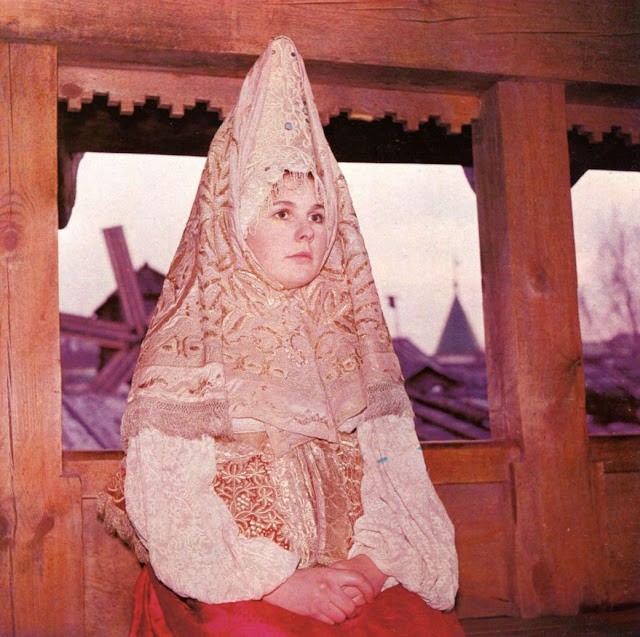
photo source
Who hasn't heard about kokoshnik? Now and then one can see kokoshnik-inspired modern creations on podiums and in fashion magazines. I believe it is the most known and recognisable garment of a traditional female costume of Russia. This very elaborate married woman's head-wear was common in the northern and central provinces of Russia and was worn on everyday basis as well as on festive occasions.
Kokoshnik, Central Russia, 19th century. Brocade, mother-of-pearl, imitation pearls, glass. The State Hermitage Museum St.Petersburg
The name comes from an old Russian word for cockerel, obviously because the shape of the kokoshnik kind of reminds that of a cock's comb: a crescent with the points reaching down to the shoulders. This is the best known and probably oldest type of kokoshnik. Though there were other shapes too: conical, cylindrical, with ear-flaps or shaped like a saddle, dipping down in the middle from the front to the back of the head.
Kokoshnik, Upper Volga region, 19th century. Velvet, metal thread embroidery. The State Hermitage Museum St.Petersburg
Kokoshnik, Pskov region, second half of the 19th century. Brocade, glass beads, embroidery. The State Hermitage Museum St.Petersburg
 Kokoshnik from Moscow region, about 1820. Velvet, silver and gold thread embroidery, coloured glass. The Museum of Fine Arts Boston
Kokoshnik from Moscow region, about 1820. Velvet, silver and gold thread embroidery, coloured glass. The Museum of Fine Arts Boston
Different shapes indicated different regions the wearers belonged to. Shorter kokoshniks were worn in the South while higher ones were more popular in the North. Another distinctive feature that pointed out the wearer's place of origin was the embellishment of the kokoshnik. The base was usually made of layers of bark or card covered with rich fabric such as damask and then decorated with pearls, glass beads, metal-thread embroidery. Kokoshniks from the North were usually embellished with the river pearls that were plentiful in that area while those from the South were more often decorated with metal thread and woolen embroideries.
In public kokoshniks were often accompanied by large shawls (platok) draped over and fastened under the chin. photo by Alexander Bozhko source
photo by Alexander Bozhko, source
Kokoshniks were ordered from monasteries, bought at village fairs or city shops. They were carefully preserved and handed down from generation to generation.
 Kokoshnik, 19th century. red silk embroidered with white cotton yarns, silver wire, glass beads and colored glass. The Museum of Fine Arts Boston
Kokoshnik, 19th century. red silk embroidered with white cotton yarns, silver wire, glass beads and colored glass. The Museum of Fine Arts Boston
Kokoshnik should not be confused with another crescent shaped headwear called venets (crown). The difference between the two is that kokoshnik was meant for a married woman and thus it had to be covering the woman's hair entirely while venets was an unmarried girl headwear and so it was open with a long piece of fabric hanging down at the back.
If you enjoyed this post please like my page on Facebook. Thank you!
Related posts






I did enjoy reading this post. I didn't know how kokosnik was called but I noticed it in some traditional Russian costumes...It doesn't suprise me it served as an inspiration to new fashion designers. Folklore is always a wonderful place to look for inspiration. Thank you for sharing these lovely images.
ReplyDeleteTo be honest ... I didn't know about the kokosnik! A more reason to read your interesting post! Your selection is gorgeous! The differences make everyone so special and unique...
ReplyDeleteGreat post! I had fun reading this. Have a fun Friday!
ReplyDeletexoxo;
STYLEFORMANKIND.COM
Facebook
Instagram
Bloglovin
I didn't know the name but looking at the photos, I recognise the look of these amazing pieces. As usual, your posts are an education, accompanied by beautiful images! xxx
ReplyDeleteI do love these kinds of posts from you Olga, I learn so much and they really are fascinating. I recognised the headpieces but I didn't know they were called kokoshniks, so I've learned something new. And the difference between them and venets. The second one of the brocade and mother of pearl is absolutely stunning. Interesting how the styles differ between north and south.
ReplyDeleteAs Curtise says, your costume posts are always a wonderful education. That first piece should be in my collection. xxx
ReplyDeleteThank you for sharing this. I know that Russia has interesting taste for culture even to the clothes.
ReplyDeleteMy favorite is from Moscow region, the velvet, silver and gold. I just love the details.
I also love how Russian designer brings this to the modern fashion :)
For your information, I know more about fahison culture from all over the world from your posts. :)
Keep it up.
Have a wonderful day!
Those are each so fantastic! They range from beautiful to bizarre on my rural American scale of things :) I love the deeper parts of Russian history. It is difficult for me to imagine Russia ever like this based on what I know of it today. I am so happy to have a better understanding. Great job!!
ReplyDeleteHi I also Don't know her name but she is wore, it's Russian culture is so different for me. It's amazing for fashion jewelry store.
ReplyDeleteThanks.